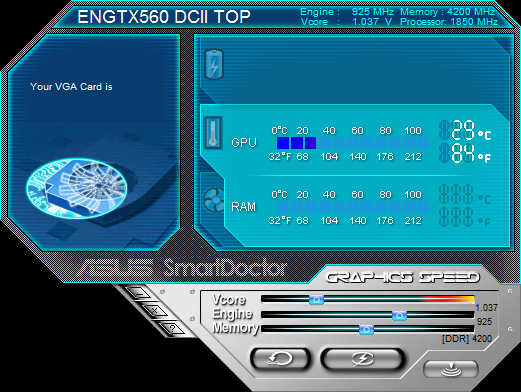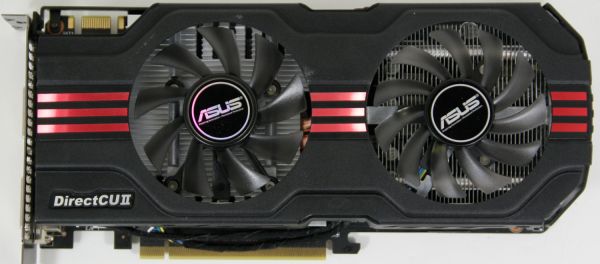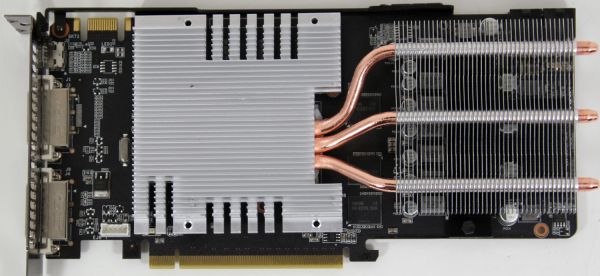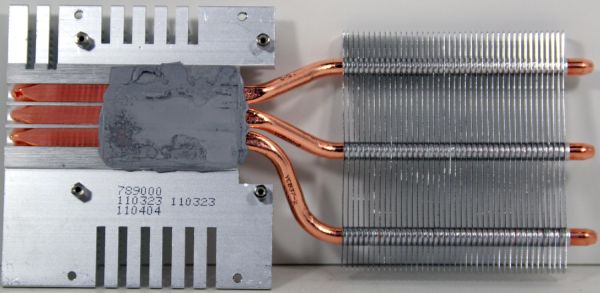NVIDIA's GeForce GTX 560: The Top To Bottom Factory Overclock
by Ryan Smith on May 17, 2011 9:00 AM ESTMeet ASUS’s GTX 560 DirectCU II Top
As we mentioned previously, the card we’re sampling today is ASUS’s GTX 560 DirectCU II Top, the faster of ASUS’s two GTX 560s, and the 2nd fastest card on NVIDIA’s launch list. It’s clocked at 925MHz for the core and 4200MHz (data rate) for the memory, giving it a sizable 115MHz (14%) core clock and 196MHz (5%) memory clock advantage over the GTX 560’s reference clocks. As we’ll see when we get to benchmarking, this is fast enough to start challenging reference clocked GTX 560 Tis.
We’ve reviewed a number of ASUS DirectCU cards in the past, but this is the first card we’ve reviewed from them that uses the DirectCU II cooler. What’s the difference? The DirectCU (I) was an open air cooler with single fan mounted at the center of the card; the DirectCU II uses two 80mm fans. In practice it’s similar to some previous coolers we’ve seen such as MSI’s Twin Frozr, however ASUS has managed to throw in their own unique adjustments.
Notably, the DirectCU II uses a different fan configuration than what we normally see with these dual-fan cards. Normally these cards are symmetrical – the left and right fans are the same. In the case of the DirectCU II ASUS is using different fans, with the left side using a taller 9 blade fan while the right side uses a more typical shorter 11 blade fan. ASUS hasn’t specifically mentioned why they do this – we’d assume they found it more efficient – but it’s an interesting deviation from what we normally see with this style of a cooler.
Removing the shroud and fans, we’re down to the actual HSF the cooler uses. ASUS has ditched the two large aluminum heatpipes running across the top of the card for a trio of smaller copper heatpipes running directly from the base of the HSF to the secondary heatsink over the rear of the card. These dual aluminum heatsink configurations are typical for dual-fan cards. Flipping the HSF over and we can see the base of the unit; ASUS has the heatpipes make direct contact with the GPU rather than using a baseplate to spread the heat out some. Both the heatpipes and the primary heatsink end up making contact with the GPU as a result.
Cooling for the VRMs is provided by small spring-loaded heatsinks attached directly to the MOSFETs. The airflow from the fans provides cooling for these heatsinks, along with some airflow over the GDDR5 memory modules to keep the card’s RAM cool.
Overall the build quality of the GTX 560 DirectCU II is up to the same solid standards we see out of an ASUS DirectCU card. ASUS continues to be the only manufacturer we see regularly using stiffening brackets with an open air cooler, making the card extremely rigid and almost impossible to flex. Even the shroud is surprisingly durable, having apparently been coated in some kind of metal or metal-like rigid plastic.
Moving on, with the factory overclock power consumption is undoubtedly higher than NVIDIA’s reference value of 150W. ASUS and other video card manufacturers don’t normally provide a TDP for the card, but we’d guess it’s around 170W, similar to that of the reference GTX 560 Ti. Providing this power is a pair of PCIe power sockets, which ASUS has helpfully oriented at the top of the card rather than the rear as we’ve seen on most other GTX 560/460 cards.
As is normally the case with ASUS DirectCU cards, the tradeoff in their design is that their cards are a bit bigger on average. Like the DirectCU (I), ASUS’ shroud is longer than the PCB itself, so while the PCB is only around 9.15” the total length of the card is just over 9.8”, versus 9” for the reference GTX 560 Ti. Meanwhile for display outputs, ASUS is following the typical NVIDIA design: 2x DVI ports and a single mini-HDMI port.
Rounding out the package, ASUS includes their usual collection of utilities: GamerOSD and SmartDoctor. SmartDoctor hasn’t changed since the last time we’ve looked at it; it still provides a passible but ultimately dated GUI for monitoring and overclocking the card. ASUS is offering voltage tweaking on this card for overclockers looking to push the card higher than 925MHz, so overvolting through SmartDoctor is a necessity for getting much farther than 925MHz. A good GF114 GPU should be able to hit near 1GHz with some extra voltage, though in our case we were only able to push our card to 950MHz, even at 1.075v.

The rest of the collection is your usual pack-in fare: a multi-language quick setup guide, a mini-HDMI to HDMI dongle, 2 molex-to-PCIe power adapters, and a DVI-to-VGA dongle.
Finally, as the GTX 560 DirectCU II Top is ASUS’s top-tier GTX 560, it also has a top-tier price: ASUS is charging an additional $20 over the GTX 560 OC, for an MSRP of $219.














66 Comments
View All Comments
Grooveriding - Tuesday, May 17, 2011 - link
Would be nice to see a comparison of the 560 to the 460 both at the same clockspeeds.Looking at this review, they will perform exactly the same at the same clocks. But it would be nice to see the comparison none the less.
xxtypersxx - Tuesday, May 17, 2011 - link
I agree, it seems to be a pretty standard refresh except whereas 460's tend to top out around 850mhz, these make it much closer to 1ghz.I hope the all of the manufacturers learned their lesson from the rash of dying 460's a few months after launch and included heatsinks on the VRM's like Asus did. These GF114/GF104 cards draw too much current when overclocked for the manufacturer's to leave the mosfets naked as they did with most launch 460's.
I also liked how the clock scaling was presented in the review, this is a good way to handle the non-standardized speeds. I'm sure you'll get the standard comment whiners screaming bias, but at this point I'm convinced they will do this whenever you show an Nvidia card even power on correctly.
L. - Thursday, May 19, 2011 - link
I'm pretty sure they didn't learn too much, seeing what happened to tdp-control on the 590 ... (i.e. nerf the card else it's gonna blow up) - quite normal though, trying to put two 350 watt gpu's on the same board was a retarded idea, since it's not supposed to be a hairdryer.iGas - Sunday, July 10, 2011 - link
I agree.Would be nice to see a direct comparison clock for clock. And, perhaps a comparison with the 470, and 480 at base clock and OC.
PS. My MSI GTX 460, humming along perfectly at 940mhz (and it did broke into 1011mhz territory).
DarknRahl - Tuesday, May 17, 2011 - link
Larger resolutions would be handy.Stuka87 - Tuesday, May 17, 2011 - link
It would be interesting to see them tested on a 27" display, but most single card setups fall on their face at that resolution (2560 x 1440).L. - Thursday, May 19, 2011 - link
Well that's where you see AMD cards (2GB) get some more points.But as discussed .. makes more sense to have 2* 1080p instead, financially.
michaelheath - Tuesday, May 17, 2011 - link
Why? Nvidia pretty much said last week that the target market for the GTX560 was users who want an affordable card to play games at 1080p resolution. Who would buy a $200 graphics card to play on a $1000+ 2560 x 1440/1600 display anyway? If you have that much money in your pockets for a high-quality display, why would you skimp out on the graphics card?Ushio01 - Tuesday, May 17, 2011 - link
http://www.overclockers.co.uk/showproduct.php?prod...Only £440 ($660).
L. - Wednesday, May 18, 2011 - link
It is clearly dumb to think resolutions will stay at the same level for eleventy beelion years.Anyone who has a good monitor wants to make use of it and might want to know how it's going to work.
Besides, your 1000 bucks figure is like 3x the price for some of the cheapest 2560* .
And, 200 bucks is not exactly "skimping out" on the gfx ...